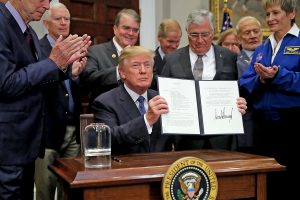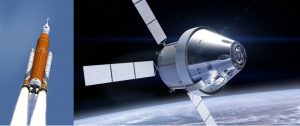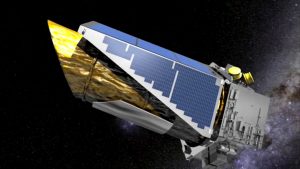To celebrate the 45th anniversary of the final Apollo mission to land on the Moon President Trump has announced (11 Dec 2017) that he is directing NASA to return American astronauts to the Moon before continuing on to Mars and ‘to many Worlds beyond’. Vice-President Pence, the head of the Council of Astronautics stood proudly beside his boss as did Harrison Schmidt, a member of Apollo 17 and one of the last two men to set foot on the Moon along with Buzz Aldren, the second man on the Moon. See image below.

Now I have published several posts (22 Feb 2017 and 19 July 2017) recommending exactly this strategy. At present NASA is nearing completion of two major space systems that could easily be employed in an updated version of the Apollo missions. The Space Launch System (SLS), which is scheduled for its first unmanned launch next year, could serve as the main launch vehicle as the Saturn V rocket did. At the same time the Orion capsule, also scheduled for a test flight next year, would take the place of the Apollo Command and Service modules. See images below.

That would mean that the only major system required to achieve President Trump’s goal is a lander module, that is an updated version of the Lunar Module or LM, a task that could be completed in 4-6 years given adequate support! My support for this strategy comes from the fact we will soon have much of the equipment necessary and it would actually allow NASA to do something after 40 years of, let’s be honest stagnation.
But here’s the problem; we’ve been through this before, many times now. A new President will come into office; directs NASA toward a completely different goal from his predecessor and does not even bother to try to get the funding necessary from Congress.
Ronald Reagan ordered NASA to build a Space Station (I did some preliminary design work on that by the by) but never funded it. George H.W. Bush told NASA to go to Mars instead but again, no bucks no Buck Rogers. Bill Clinton was less ambitious, he went back to Reagan’s Space Station idea, got some other nations, especially Russia involved and managed to get the International Space Station built! After that George W. Bush decided it was time for us to go back to the Moon so NASA came up with the Constellation Program from which came the initial designs for the SLS and Orion capsule. But President Obama thought the cost of Constellation was too high so he instructed NASA to use a mission to an asteroid as a stepping-stone to an eventual Mars Mission.
Think of all of the billions of dollars that have been wasted going back and forth from one plan to another. Maybe if two Presidents in a row stuck to the same plan NASA might actually have gotten somewhere. And that’s my concern; with all of Trump’s problems what are the chances that he’ll be able to support, or even care about his space vision at all. And then the next President will just scrap all the work done on going back to the Moon for whatever his or her vision is.
Meanwhile however NASA continues to show how it can perform miracles even without adequate funding. Scientists at NASA’s Ames research facility in Sunnyvale California have collaborated with their neighbors Google to use Artificial Intelligence (AI) to review the massive amounts of data gathered by the Kepler Space Telescope.
Now, in case you’ve forgotten, the Kepler satellite (see image below) was designed to observe thousands of stars looking for slight dips in their brightness that could be caused by planets. The stars that Kepler detected as possibly having planets were then examined more closely by ground-based telescopes to confirm the existence of planets. To date Kepler has examined 150,000 stars found over 3,000 confirmed planets orbiting other stars.

But the scientists managing the Kepler mission were convinced that more planets could be hidden inside the Kepler data so they teamed with AI engineers at Google to use machine learning to review the Kepler data and they’ve already found a big one.
Two days ago, 14 Dec2017, NASA announced that the star Kepler-90 possesses a solar system of eight planets, a number equal to our own solar system. Now Kepler-90 is a star similar to our Sun at a distance of about 2,500 light years and the Kepler satellite had already discovered several planets orbiting around. How many the researchers weren’t certain so they used the data from Kepler-90 as some that would be reexamined by Google’s AI and the computer learned how to sift through the observations to find eight planets. The image below shows an artist’s impression of what Kepler-90’s family of planets could look like.

With this early success behind them the Kepler-Google team will surely go on to discover thousands of more planets orbiting other stars and many of those planets could be a home to who knows what forms of life. This is a lesson to be learned about America’s scientists. Even when the politicians bicker about and underfund science, they keep finding ways to make amazing discoveries.
